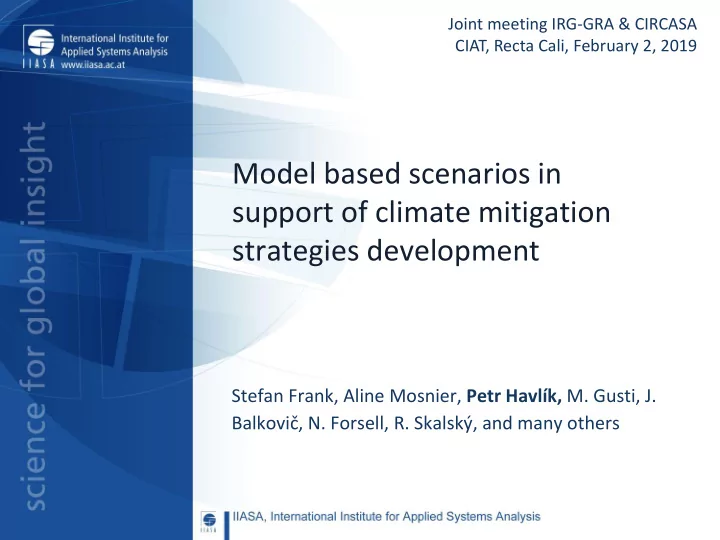

Joint meeting IRG-GRA & CIRCASA CIAT, Recta Cali, February 2, 2019 Model based scenarios in support of climate mitigation strategies development Stefan Frank, Aline Mosnier, Petr Havlík, M. Gusti, J. Balkovič , N. Forsell, R. Skalský, and many others
Supporting the EU NDC & LTS development 2020 targets: 20% GHG reduction, renewable and energy efficiency 2030 targets/NDC: 40% GHG reduction -43% ETS: covering power plants and large industrial installations -30% non-ETS covering smaller industries, transport, ag. non-CO 2 … Limited access to LULUCF credits No specific target for agriculture yet 2050 climate strategy: GHG neutral by 2050 Long- Term Strategy “A clean planet for all”
EU – Climate modeling framework EU GLOBAL GEM-E3 Macro-economic Macro-economic drivers & impact QUEST Macro-economic impact E3ME Macro-economic impact Prometheus Energy demand Energy PRIMES POLES Energy system CO2 All sectors excl. AFOLU GAINS IMAGE non-CO2 emissions All sectors GLOBIOM/G4M CAPRI Global – AFOLU GHGs AFOLU EU – LULUCF CO2 Agriculture activities
From global targets to national commitments Global models develop consistent climate stabilization pathways Detailed regional model 1.5 C pathway for EU quantify EU pathway consistent with global target Source: EC, LTS
GLOBIOM Seafood MARKET, TRADE, PRICES FEED TBD Fish model → Feed supply, intake → Fish processing → GHG emissions Worldwide: 11 species groups Capture/aquaculture Freshwater/marine Small-/large-scale Fishmeal and fish oil 5 feed crops Water surface FAO Fishing Areas / 0.5° Grid
From global targets to national commitments Calibration with national GHG inventories and other statistics to ensure consistency in projections
Technical non-CO2 mitigation options based on US EPA database Different crop and livestock technologies CH4 and N2O emission reduction achieved by technology Related impacts on productivities Costing: +Capital/investment costs +Operating and maintenance costs +Labor +Fertilizers +Energy +Other inputs - Other revenues e.g. from biogas production etc. +Inertia constraint on adoption rates (quadratic cost function)
Technical non-CO2 options based on EPA database Different crop and livestock technologies CH4 and N2O emission reduction achieved by technology Related impacts on productivities Costing: +Capital/investment costs +Operating and maintenance costs +Labor +Fertilizers +Energy +Other inputs - Other revenues e.g. from biogas production etc. +Inertia constraint on adoption rates (quadratic cost function) US EPA 2014
Non-CO2 mitigation in GLOBIOM EU28 Global Supply side options: Technologies: Technical options based on EPA (2015) Structural change: Transition in production systems (Havlik et al. 2014)
Lifestyle changes in EU LTS Several diet Diet 1 Diet 2 Diet 3 Diet 4 Diet 5 Bovine meat -50% -50% -50% -50% -50% options tested Sheep and goat meat -50% -50% -50% -50% -50% Milk 2010 2010 -50% -50% -50% LTS finally Pig meat BAU 2010 BAU 2010 -50% relied on Diet4 Poultry meat BAU 2010 BAU 2010 -50% Eggs BAU 2010 BAU 2010 -50% Sensitivity around international trade response
Soil Organic Carbon: EPIC Average annual change in the total SOC content in 0- 30 cm ploughing layer (OCPD in t/ha) when converted from conventional to reduced tillage Source: Balkovič et al.
Soil organic carbon and food trade-offs Land based mitigation without considering soil organic carbon would lead to a rise in undernourishment of 40 to 170 million people in 2050 While including the SOC into the mitigation portfolio would limit the additional number of undernourished to to 10 - 40 million people Source: Frank et al. ERL (2017)
Nature, 29 July 2010
Who are the stakeholders? Dilma Gilberto Rousseff Câmara GLOBIOM-Brazil Scenarios High- level meeting about Brazil’s iNDC
Recommend
More recommend